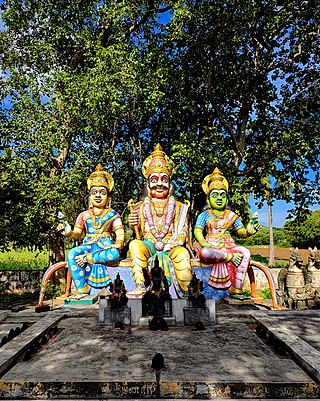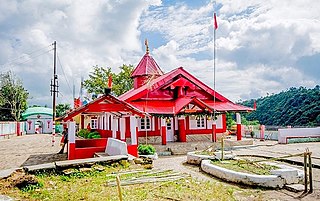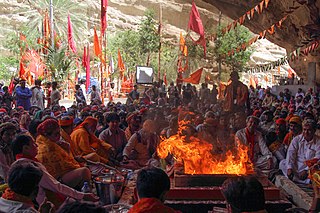
Indian religions, sometimes also termed Dharmic religions or Indic religions, are the religions that originated in the Indian subcontinent. These religions, which include Buddhism, Hinduism, Jainism, and Sikhism, are also classified as Eastern religions. Although Indian religions are connected through the history of India, they constitute a wide range of religious communities, and are not confined to the Indian subcontinent.

The North-West Frontier Province was a province of British India from 1901 to 1947, of the Dominion of Pakistan from 1947 to 1955, and of the Islamic Republic of Pakistan from 1970 to 2010. It was established on 9 November 1901 from the north-western districts of the British Punjab, during the British Raj. Following the referendum in 1947 to join either Pakistan or India, the province voted hugely in favour of joining Pakistan and it acceded accordingly on 14 August 1947. It was dissolved to form a unified province of West Pakistan in 1955 upon promulgation of One Unit Scheme and was reestablished in 1970. It was known by this name until 19 April 2010, when it was dissolved and redesignated as the province of Khyber Pakhtunkhwa following the passing of the Eighteenth Amendment to the Constitution of Pakistan, by President Asif Ali Zardari.

In the field of comparative religion, many scholars, academics, and religious figures have looked at the relationships between Hinduism and other religions.

The Adivasi are heterogeneous tribal groups across the Indian subcontinent. The term is a Sanskrit word coined in the 1930s by political activists to give the tribal people an indigenous identity by claiming an indigenous origin. The term is also used for ethnic minorities, such as Chakmas of Bangladesh, mulbasi Tibeto-Burman of Nepal, and Vedda of Sri Lanka. The Constitution of India does not use the word Adivasi, instead referring to Scheduled Tribes and Janjati. The government of India does not officially recognise tribes as indigenous people. The country ratified the International Labour Organization (ILO) Convention 107 on Indigenous and Tribal Peoples of the United Nations (1957) and refused to sign the ILO Convention 169. Most of these groups are included in the Scheduled Tribe category under constitutional provisions in India.
Owing to its ethnic and cultural diversity, religion in Arunachal Pradesh has been a spot for the syncretism of different traditional religions. Much of the native Tani populations follow an indigenous belief which has been systematised under the banner "Donyi-Polo" (Sun-Moon) since the spread of Christianity in the region by Christian missionaries in the second half of the 20th century. The province is also home to a substantial Tibetan Buddhist population in the north and northwest who follow Tibetan Buddhism, of ethnic groups who subscribe to Hinduism, and other religious populations. Christianity is followed by over 30.26% of the population, mostly by natives.

The Kharia are an Austroasiatic tribal ethnic group from east-central India. They originally speak the Kharia language, which belong to Austroasiatic languages. They are sub-divided into three groups known as the Hill Kharia, Delki Kharia and the Dudh Kharia. Amongst them, the Dudh Kharia is the most educated community.
The tribes of Jharkhand consist of 32 scheduled tribes inhabiting the Jharkhand state in India. In 1872, only 18 tribes were counted among the scheduled tribes from which Banjara, Bhatudi, Chik Baraik, and Mahli were marked as semi-Hindu aboriginal and Kora as proletariat Hindu. In the 1931 census, including the above four semi-Hindu aboriginal and Kora, a proletariat Hindu, the number was raised to 26 from 18. They were Birajia, Godait, Karmali and Paharia, but Kisan was excluded from the list. In the 1941 census, Baga, Bedia and Lohra were included again taking Kisan in the annexure and the number came to 30 which prevailed till June 2003. Kanwar and Kol were added on 8 June 2003 in the annexure and the number of Schedule Tribes came to 32.
Chuhra, also known as Bhanghi and Balmiki, is a Dalit caste in India and Pakistan. Populated regions include the Punjab region of India and Pakistan, as well as Uttar Pradesh in India, among other parts of the Indian subcontinent such as southern India. Their traditional occupation is sweeping, a "polluting" occupation that caused them to be considered untouchables in the caste system.

The official religion of Pakistan is Islam, as enshrined by Article 2 of the Constitution, and is practised by approximately 96.47% of the country's population. The remaining 3.53% practice Hinduism, Christianity, Ahmadiyya Islam, Sikhism and other religions.
Asia is the largest and most populous continent and the birthplace of many religions including Buddhism, Christianity, Confucianism, Hinduism, Islam, Jainism, Judaism, Shinto, Sikhism, Taoism, and Zoroastrianism. All major religious traditions are practiced in the region and new forms are constantly emerging. Asia is noted for its diversity of culture. Islam and Hinduisms are the largest religion in Asia with approximately 1.2-1.3 billion adherents each.

Afghanistan is an Islamic state, in which most citizens follow Islam. As much as 90% of the population follows Sunni Islam. According to The World Factbook, Sunni Muslims constitute between 84.7 and 89.7% of the population, and Shia Muslims between 10 and 15%. Other religions are followed by 0.3% of the population.
The indigenous people of Bangladesh are ethnic minorities in Chittagong Hill Tracts (southeastern), Sylhet Division (northeastern), Rajshahi Division (west), and Mymensingh Division (north-central) areas of the country. They are indigenous and the tribal races, total population of ethnic minorities in Bangladesh was estimated to be over 2 million in 2010. They are diverse ethnic communities including Tibeto-Burman, Austric and Dravidian people.

Religion in India is characterised by a diversity of religious beliefs and practices. Throughout India's history, religion has been an important part of the country's culture and the Indian subcontinent is the birthplace of four of the world's major religions, namely, Buddhism, Hinduism, Jainism, and Sikhism, which are collectively known as native Indian religions or Dharmic religions and represent approx. 83% of the total population of India.

Christians are a religious community residing in the Indian state of Jharkhand. As per 2011 Census of India, 4.3% of people in Jharkhand are Christians. Christians are majority in Simdega district of Jharkhand.

The early Dravidian religion constituted a non-Vedic, pre-Indo-Aryan, indigenous religion practiced by Dravidian peoples in the Indian subcontinent that they were either historically or are at present Āgamic. The Agamas are non-Vedic in origin, and have been dated either as post-Vedic texts, or as pre-Vedic compositions. The Agamas are a collection of Tamil and Sanskrit scriptures chiefly constituting the methods of temple construction and creation of murti, worship means of deities, philosophical doctrines, meditative practices, attainment of sixfold desires and four kinds of yoga. The worship of tutelary deities and sacred flora and fauna in Hinduism is also recognized as a survival of the pre-Vedic Dravidian religion. Dravidian linguistic influence on early Vedic religion is evident; many of these features are already present in the oldest known Indo-Aryan language, the language of the Rigveda, which also includes over a dozen words borrowed from Dravidian. The linguistic evidence for Dravidian impact grows increasingly strong as one moves from the Samhitas down through the later Vedic works and into the classical post-Vedic literature. This represents an early religious and cultural fusion or synthesis between ancient Dravidians and Indo-Aryans that went on to influence Indian civilisation.

Sarnaism is a religious faith of the Indian subcontinent, predominantly followed by indigenous communities in the Chota Nagpur Plateau region across states like Jharkhand, Odisha, West Bengal, Bihar, and Chhattisgarh.
Chennai is religiously cosmopolitan, with its denizens following various religions, chief among them being Hinduism, Islam, Christianity, Sikhism, Jainism, Buddhism, and Zoroastrianism. Chennai, along with Mumbai, Delhi, Kochi, and Kolkata, is one of the few Indian cities that are home to a diverse population of ethno-religious communities.

Hinduism is a minority religion in the Meghalaya state of India constituting 12% of the state's population. The Nartiang Durga Temple in Meghalaya is one of the 51 Shakti peethas on Earth and is considered by Hindus of Meghalaya as the permanent abode of Goddess Durga. Hinduism is a popular religion practice by Rabhas, Hajongs, Kochs, Rajbongshis, Mikirs, Bengalis, Nepalis, Biharis etc.

Hinduism is a minority religion in Balochistan followed by 0.4% of the population of the province. It is the largest minority religion in Balochistan. The Balochistan is home to the shrine of Shri Hinglaj Mata temple, which is one of the most sacred Hindu temples. The annual Hinglaj Yatra to the temple is the largest Hindu pilgrimage in Pakistan.













